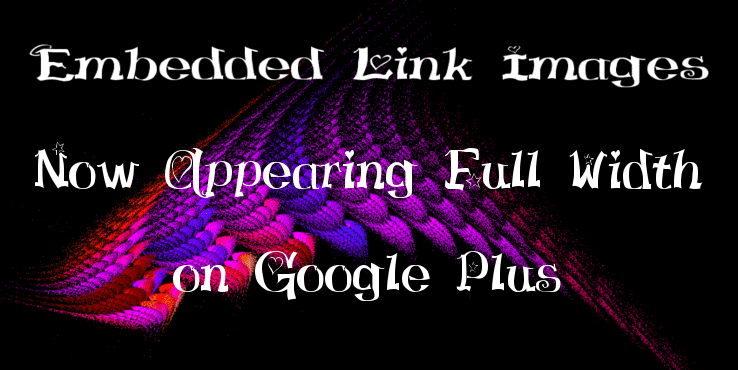The Google Plus social network apparently has just begun displaying link images as full-width photographs — not simply as thumbnails.
[UPDATE: From Saturday, March 15 through Monday, March 17 — the Ides of March through Saint Patrick’s Day — Google Plus links reverted to the old-style thumbnail images. As of today, March 18, they are back to showing in the new wide format. I’m assuming Google needed that time to digest its lessons from the initial roll-out and overhaul its code accordingly.]
This is a big deal for bloggers and web developers.
In the past, if I created a blog post or web page, and wanted to promote it on Google Plus, I faced a difficult choice: I could post it as a link, or as a photo, but not both.
As a link, the social-media post would display a relatively tiny thumbnail, alongside a text headline. Posts of this kind were relatively invisible in the Google Plus stream, which typically is bursting with flashy photographs, moving GIF animations, and other catchy images.
I could also post a photo illustrating the blog page, along with a link. In this case, however, the image itself would not link to the post. Most people would simply click on the image. But many web publishers still preferred photo posts, simply because these — being much more visible — tend to generate more engagement.
Facebook, until recently, posed the same choice. But Facebook recently introduced an option to display link-images full-width. Now Google Plus seems to have followed suit, going Facebook one better:
From preliminary testing, it appears Google Plus link images can be any size or shape. Facebook link images must be a strict 1.91 to 1, among other constraints.
The more relaxed Google Plus approach seems to give Big G an advantage in terms of website friendliness. This initiative seems sure to attract many more developers to the Google platform.
Two questions remain:
➊ If link images now can go full width, can they also go full stream? (Some photo posts are spread by Google across both columns of the display, and are very eye-catching. So far, no one I’ve heard from has heard of a link-post going full-stream in the same way.)
➋ Will Google update its mobile apps to reflect this change? (So far, it seems to work only on the desktop. My iPad is still showing link thumbnails. My guess is that mobile apps will follow suit — but that’s only a guess.)
Lots more information about this change will no doubt be forthcoming in the next few days!


2 responses to “Google Plus displaying full-width link images”
Hi Gary, this does not work on most of my Google Plus sites (I have a few). All completely different. Although it has worked on a couple. It’s a great idea and the thumbnails really annoyed me! It is two years later. You would think that Google would have fully rolled it out in that time. Any suggestions?
Chris, the trick — with a WordPress website, at least — is to give your WordPress post a “featured image” with dimensions of 1200 x 628. On Google Plus, lots of other sizes will work also. (I recommend 1200 x 628 because that size also results in full-width link images on Facebook.)
When you then post a link to your WordPress article, on Google Plus (or Facebook), it should display there with a full-width image that links to your article. The image should span the entire width of the column. The headline and your article’s “meta” description will be underneath it. Not just a thumbnail with the headline beside it.
If this doesn’t work, there may be some configuration anomaly in your site structure. This doesn’t necessarily mean you did anything wrong. It could be a bug in Google Plus or a bug in your theme, or not even a bug: merely that their respective softwares are somehow incompatible. Off and on I’ve had trouble making the full-width link process work, more often with Facebook than with Google Plus. And then it would just go back to working, even though I did nothing different.
If it still isn’t working, I’d recommend installing the free Yoast plugin for SEO (search engine optimization). Let it handle your featured images, meta descriptions, and the like. This may or may not help solve the problem, but I’ve found it useful for some link-display problems I encountered in the past. Otherwise, try various Google searches and there’s a good chance you’ll find a solution (but no guarantee).
Best of luck with your efforts!